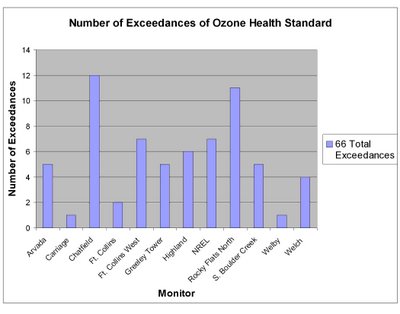Summer Ozone in Review
The summer is coming to an end, meaning ozone levels too are coming down to less unhealthy levels. Although ozone pollution can be a problem any time of the year, summer is definitely the season with the greatest pollution problems.
With that said, it's time to count the toll that this last summer's ozone had on Denver area communities and to review where we're at. Let's take a look:
- According to state monitoring, maximum 8-hour ozone levels reached or exceeded the health standard of 80 parts per billion 66 times at the various monitors from Chatfield to Greeley.

- Peak 8-hour ozone levels reached or exceeded 80 parts per billion at the Chatfield monitor 12 times.
- The highest 8-hour ozone concentration was 97 parts per billion and was reported from the Fort Collins West monitor on July 14.
- Ozone levels exceeded 80 parts per billion at 12 monitors along the Front Range.
- Only one monitor, the CAMP monitor located in downtown Denver, did not show high ozone pollution.
- Denver will violate federal ozone standards if the three year average of the fourth highest ozone levels reaches 85 part per billion or higher. Because of this summer's ozone, a fourth highest reading of 84 parts per billion or higher at the Chatfield monitor next year will cause Denver to violate the standard. The fourth highest ozone value has reached or exceeded 84 parts per billion two of the last three years at Chatfield.

0 Comments:
Post a Comment
<< Home